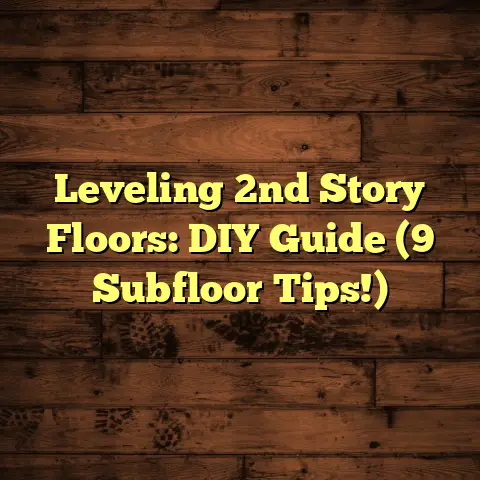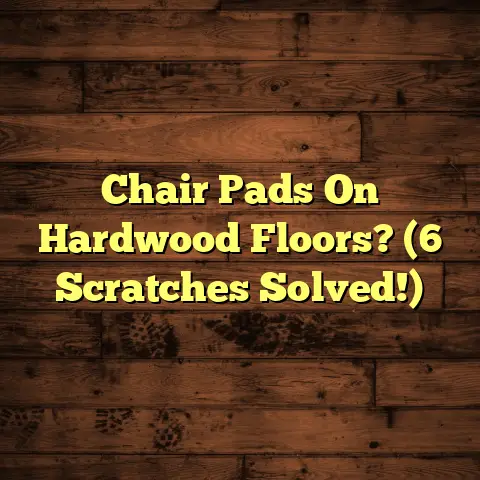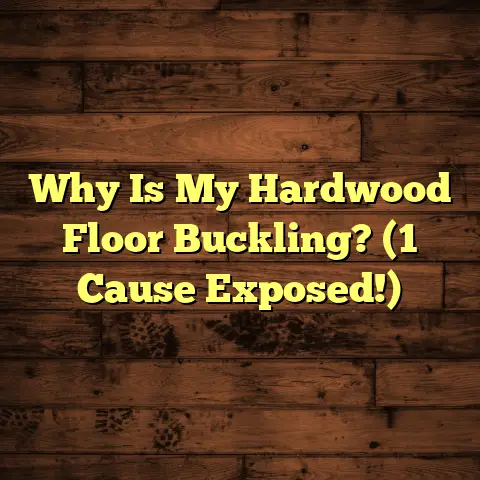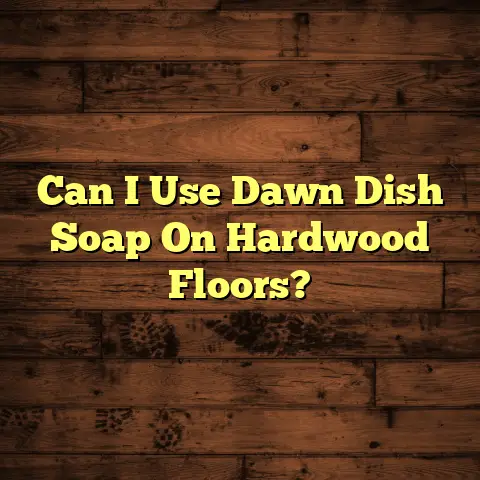Why Is My Vinyl Plank Buckling? (1 Reason!)
And you know what? I’m here to spill the beans on a common problem I see all too often: buckling vinyl plank flooring.
Vinyl plank has become incredibly popular, and for good reason. It’s durable, looks great, and is super easy to clean.
I mean, who doesn’t love a floor you can just mop and forget about? No more endless scrubbing or special cleaning solutions, right?
But sometimes, even the easiest-to-maintain flooring can throw us for a loop.
That’s where buckling comes in, and trust me, it’s not a pretty sight. It can turn your beautiful, low-maintenance floor into an eyesore.
And potentially even a tripping hazard.
So, why does this happen? What causes those frustrating bumps and waves in your vinyl plank?
Well, let’s dive in and get to the bottom of it!
Understanding Vinyl Plank Flooring
Okay, let’s start with the basics. What exactly is vinyl plank flooring?
Think of it as a multi-layered marvel of modern flooring technology. It’s typically made up of four layers:
-
The Wear Layer: This is the top layer, the one that takes all the abuse from foot traffic, scratches, and spills. It’s usually a clear, protective coating.
-
The Print Layer: This is where the magic happens! It’s a high-definition image that gives the vinyl plank its realistic wood or stone look.
-
The Core Layer: This is the heart of the plank, providing stability and strength. It’s often made of PVC vinyl.
-
The Backing Layer: This bottom layer provides cushioning and helps the plank adhere to the subfloor.
Now, you’ve probably heard of different types of vinyl plank, like Luxury Vinyl Plank (LVP).
What’s the deal with that? Well, LVP is generally thicker and higher quality than standard vinyl plank.
It often has a more realistic look and feel, and it’s more durable. Think of it as the premium version of vinyl plank.
I’ve seen homeowners use vinyl plank everywhere – kitchens, bathrooms, basements, you name it!
Its water resistance is a huge selling point, making it perfect for those areas prone to moisture.
Plus, it’s softer and warmer underfoot than tile or hardwood, which is a nice bonus, especially in colder climates.
The Problem of Buckling
Alright, let’s talk about the elephant in the room: buckling. What does it even mean for your vinyl plank to buckle?
Basically, it means that the planks are lifting up from the subfloor, creating bumps, waves, or tenting.
Imagine a perfectly flat surface suddenly developing hills and valleys – that’s buckling in a nutshell.
You might see it as a single plank lifting up in the middle, or as a series of planks forming a wave-like pattern across the floor.
Here’s a visual for you: think of a piece of paper that gets wet and then dries unevenly. It warps and buckles, right?
That’s kind of what happens to vinyl plank when it buckles.
Buckling isn’t just an aesthetic issue. It can also be a safety hazard.
I’ve seen people trip and fall on buckled floors, especially elderly folks or those with mobility issues.
Plus, the buckled planks can become damaged over time. The edges can chip or crack, and the surface can become scratched.
And let’s not forget the cost! Repairing or replacing buckled flooring can be expensive.
You might have to replace entire sections of the floor, which means labor costs and material costs.
Trust me, it’s a headache you want to avoid.
The Primary Cause of Buckling
Okay, here’s the million-dollar question: what causes vinyl plank to buckle?
While there can be contributing factors, the primary culprit, the one I see causing the vast majority of buckling issues, is moisture.
Yep, that’s right. Water. H2O. The very thing that vinyl plank is supposed to resist!
But here’s the thing: vinyl plank is water resistant, not waterproof.
That means it can handle spills and splashes, but it’s not invincible.
Excessive moisture can seep into the seams between the planks, especially if the installation wasn’t done properly.
And where does this moisture come from? All sorts of places!
- Spills: Obvious, right? A large spill that isn’t cleaned up quickly can seep into the seams.
- Leaks: A leaky pipe, a dripping faucet, or even a slow leak in your roof can cause moisture to build up under the floor.
- Humidity: High humidity levels, especially in basements or bathrooms, can cause moisture to condense on the floor.
- Improper Installation: This is a big one! If the subfloor isn’t properly sealed or if there aren’t adequate expansion gaps, moisture can easily get trapped.
So, how does moisture actually cause buckling? It’s all about expansion and contraction.
Vinyl plank, like most materials, expands when it gets warm or wet and contracts when it gets cold or dry.
When moisture gets into the planks, they expand. If they don’t have enough room to expand, they push against each other.
This creates pressure, and eventually, the planks start to buckle.
Think of it like trying to squeeze too many people into a small elevator – eventually, someone’s going to get pushed out of place!
I remember one case where a homeowner had a slow leak under their kitchen sink.
They didn’t notice it for months, but eventually, the vinyl plank in the kitchen started to buckle.
When I pulled up the planks, I found a pool of water underneath! The moisture had caused the planks to expand and push against each other.
In another case, a homeowner had installed vinyl plank in their basement without properly sealing the concrete subfloor.
Moisture from the ground was seeping up through the concrete, causing the planks to buckle.
These are just a couple of examples, but I’ve seen countless cases where moisture was the root cause of buckling.
The Role of Installation
Okay, so we know that moisture is the primary culprit behind buckling.
But what role does installation play? Can a bad installation make the problem worse? Absolutely!
Proper installation is crucial for preventing moisture issues and ensuring that your vinyl plank floor lasts for years to come.
Here are a few key things to keep in mind:
-
Acclimation: This means allowing the vinyl plank to adjust to the temperature and humidity of the room before installation.
Most manufacturers recommend acclimating the planks for at least 48 hours. This helps to minimize expansion and contraction after installation.
-
Subfloor Preparation: The subfloor needs to be clean, dry, and level. Any imperfections in the subfloor can create uneven pressure on the planks, making them more susceptible to buckling.
-
Expansion Gaps: These are small gaps left around the perimeter of the room and around any vertical obstructions, like pipes or door frames.
They allow the planks to expand and contract without putting pressure on each other or on the walls.
I usually recommend leaving a gap of at least 1/4 inch.
-
Sealing: If you’re installing vinyl plank in a moisture-prone area, like a bathroom or basement, it’s important to properly seal the subfloor and the seams between the planks.
This will help to prevent moisture from seeping in.
I’ve seen so many cases where a bad installation led to buckling, even when there wasn’t a major moisture problem.
For example, if the installer doesn’t leave adequate expansion gaps, the planks will have nowhere to expand.
This can cause them to push against each other and buckle, even if there’s no excessive moisture.
Or, if the subfloor isn’t properly prepared, the planks can become uneven and unstable, making them more vulnerable to moisture damage.
Here’s a tip: always follow the manufacturer’s instructions for installation.
They know their product best, and their instructions are designed to ensure a successful installation.
Don’t try to cut corners or skip steps – it could end up costing you more in the long run.
Recognizing and Diagnosing the Issue
So, how do you know if your vinyl plank is buckling? And what can you do to figure out the cause?
Here are a few things to look for:
-
Visible Bumps or Waves: This is the most obvious sign of buckling. Look for areas where the planks are lifting up from the subfloor.
-
Uneven Surface: Run your hand across the floor. Do you feel any bumps or dips? This could indicate buckling.
-
Gaps Between Planks: If the planks are expanding and contracting excessively, you might notice gaps forming between them.
-
Cracking or Chipping: Buckled planks are more likely to become damaged. Look for cracks or chips along the edges.
If you suspect that your vinyl plank is buckling, here’s what you should do:
- Inspect for Moisture Sources: Check for leaky pipes, dripping faucets, or signs of water damage around the perimeter of the room.
- Check the Subfloor: If possible, lift up a few planks and inspect the subfloor. Is it damp or moldy?
- Examine the Installation: Are there adequate expansion gaps? Was the subfloor properly prepared?
- Document Your Findings: Take photos and notes of everything you find. This will be helpful when you talk to a flooring contractor or insurance adjuster.
Don’t try to fix the problem yourself unless you’re experienced with flooring installation.
You could end up making the problem worse.
Instead, call a qualified flooring contractor to assess the situation and recommend a solution.
They’ll be able to identify the source of the moisture, repair any damage, and ensure that the flooring is properly installed.
Conclusion
Alright, let’s wrap things up. We’ve covered a lot of ground here, from understanding what vinyl plank flooring is to diagnosing the causes of buckling.
The key takeaway? Moisture is the primary culprit behind buckling in vinyl plank flooring.
Whether it’s from spills, leaks, humidity, or improper installation, excessive moisture can cause the planks to expand and buckle.
By understanding the role of moisture and taking steps to prevent it, you can keep your vinyl plank floor looking beautiful for years to come.
Remember, proper installation is crucial. Follow the manufacturer’s instructions, prepare the subfloor properly, and leave adequate expansion gaps.
And be vigilant about checking for moisture sources. Repair any leaks promptly, and keep humidity levels under control.
By taking these precautions, you can avoid the headache and expense of dealing with buckled vinyl plank flooring.
And you can continue to enjoy the low-maintenance, beautiful floor that you invested in.
Thanks for joining me today! I hope this article has been helpful.
If you have any questions or comments, feel free to leave them below. And remember, when it comes to flooring, knowledge is power!





